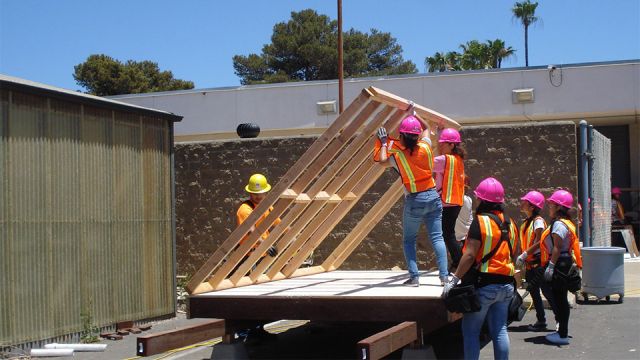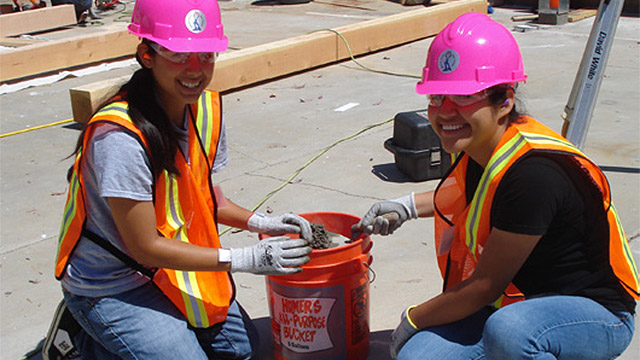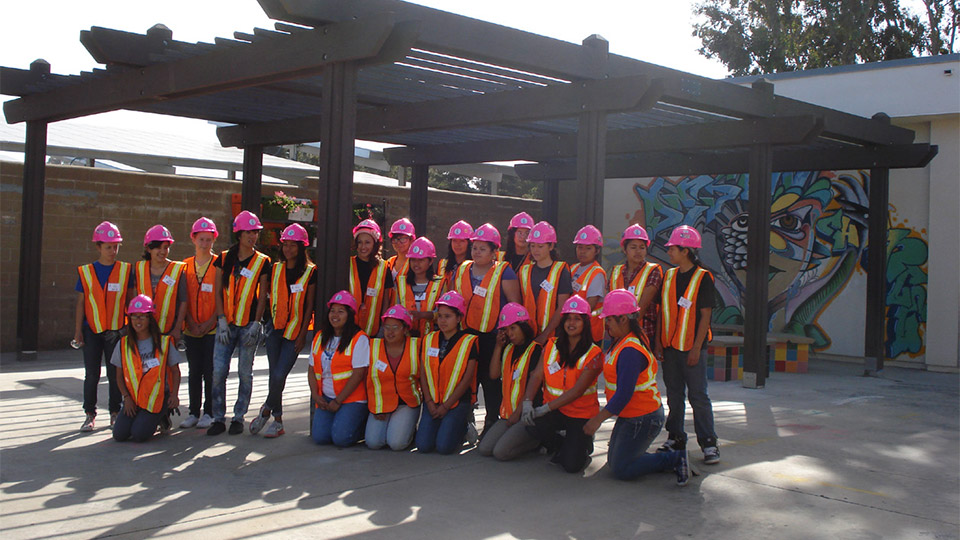Camp NAWIC uses community service to get high school girls interested in construction
Camp allows NAWIC members the chance to meet and mentor young girls
By Chris Towery
It is no secret that the construction industry has always been a very male-dominated profession. Even today, with more women working in the field than ever before, just take a quick glance at any construction site and you will see that there is still quite an uneven ratio of men to women. However, the National Association of Women in Construction (NAWIC), which was launched in 1955 to create a support network for females in the industry, has been working tirelessly to help women better integrate into the profession. As demonstrated by a successful training camp run by the NAWIC San Diego chapter, the organization is reaching out to recruit future members while they are still in high school.
The San Diego chapter of NAWIC has existed for more than 50 years and currently boasts some 75 members. Nearly a decade ago, the chapter began hosting all-female camps. The camps were created as a community outreach program targeting high school girls to kindle their interest in pursuing a construction career.
Working together with an area high school and numerous volunteers from the local construction industry, the San Diego chapter put on its first camp in 2008. The first camp, which attracted around 20 girls, was a huge success, and the chapter has been holding similar camps each year since then. Ultimately, the camp allows NAWIC members the chance to meet and mentor young girls in the hopes that they will have professional role models in the industry.
“The camp and NAWIC mentors offer high school girls a role model situation where they can say, ‘Well, she worked in that industry and is doing well, so maybe I can do that too,’” said Linda A. Young, CBT, CIT, Camp NAWIC co-director.
Run every summer since 2008, Camp NAWIC attracts approximately 24 high school girls each year. In all, more than 150 campers have participated since the camp’s inception. Camp NAWIC is held at Kearny High School’s Stanley Foster School of Engineering, Innovation & Design (EID), formerly known as the Stanley Foster Construction Tech Academy (CTA). EID is a smaller academy within Kearny High that offers students coursework in architecture, engineering and construction. During the five-day camp, the girls receive an introduction to many different crafts, along with handson experience working on a real construction project.
“Since EID already has classroom facilities and labs set up where the kids can work, it’s the perfect place to hold the camp,” said Young. “The staff at EID have worked really well with us over the years, and this has been an important factor in our success.”
“This can’t be taught in a class—they have to experience it firsthand. It’s amazing to see how much this builds their self-confidence.”
Young said that such hands-on work is especially valuable for females interested in a construction career.
“Unlike most boys, girls often don’t have any experience with building things like this, so the hands-on component is very important,” said Young. “Many of the girls initially come to camp thinking they could never learn to do these things, but by the end of the week, they have a real sense of accomplishment and can say, ‘I know I can do that.’ This can’t be taught in a class—they have to experience it firsthand. It’s amazing to see how much this builds their self-confidence.”
To provide the girls with a realistic sense of how the construction industry operates, the camp is organized in a two-tiered structure, wherein girls attending the camp for the first year are considered apprentices, and those with one or more years’ experience are classified as journeymen. During the week, volunteers from NAWIC and local industry provide apprentice-level campers with a basic introduction to numerous construction crafts, and if there is time, the apprentices can do some hands-on work on the project as well. Campers returning for their second year and beyond are considered journeymen, and they work full time each day building the project.
Because the projects involve numerous tasks across many crafts, each journey-level camper has the chance to work on many different hands-on jobs. From there, instructors assess where each girl’s strengths lie and have them focus primarily on the tasks they are best at.
“The instructors work it out so that all of the girls get to do a little bit of everything,” said Young. “Everyone gets a turn with the paintbrush, cutting wood with a saw, putting on shingles and so on. Then, they find what the girls do best and place them on those tasks, so everyone has a sense of accomplishment.”
Young gives special credit to Jack Chapel from the Associated General Contractors of America who has been the camp’s project leader for seven years. Linda notes that Chapel’s background and experience in education has made him the ideal person to oversee the camp projects.
“We’re very fortunate to have Jack Chapel, who used to be a teacher at CTA and then moved on to AGC’s apprenticeship program, where he is now director of education,” said Young. “He has been the project leader for all of the years we’ve had the camp, and he brings other people from AGC who function as team leaders.”
The assistance that the local construction industry provides to Camp NAWIC is essential to its operation and success. Since the start, a core group of contractors, construction associations, training programs and unions have not only fielded volunteers to help run the camp, but they have also donated building materials and equipment. Young estimates that it can take up to $20,000 to run just one week-long camp, and though NAWIC holds a golf tournament fundraiser to help generate funding, the majority of financing comes from industry donations.
Funding is such an ongoing issue that the San Diego NAWIC created a charitable foundation called the SD NAWIC Future Construction Leaders Foundation so they can receive monetary donations and apply for grants. The foundation received final approval for the foundation in spring of 2015, which has opened the door to new sources of financing.
Over the past seven years, Camp NAWIC has not only introduced hundreds of girls to the construction industry, the organization has also seen several of the camp graduates go on to develop careers within the profession. Such achievements provide validation for all of the hard work undertaken by camp organizers and volunteers. “At this point, we can point to five or six girls who’ve gone through the camp and have obtained engineering and construction management degrees from San Diego State University and have jobs in the industry, so we have seen some real success,” said Young.
Moreover, Young reports that nearly all of the volunteers who have helped staff and fund the camp over the years are always eager to participate in future camps. She stresses that a big part of the camp’s success is due to the fact that its partners—NAWIC, EID and the local construction industry—work together as a team to serve both the girls and the community.
“When I email our industry partners, nearly everyone replies, ‘Yes, you can count on us to get involved again,’” said Young. “If the camp wasn’t successful, they wouldn’t participate. We’re so glad they do because we couldn’t pull it off without them; we’ve really built this camp together. NAWIC may have taken the lead on it, but it really takes the whole community to make something like this work.”
About the Author
This article was originally published in the Spring/Summer 2015 edition of NCCER’s The Cornerstone magazine (http://www.nccercornerstone.org/publications/publications-archive). This content has been republished with the permission of NCCER and the publisher.






















